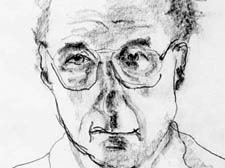|
|
 |
| |

A self-portrait sketch by Dr Cliff Myerson |
Doc who turned to art when the writing was on the wall
When he realised he was dying, GP Cliff Myerson turned the front room of his family home into an exhibition space to display the art he created in his final few months, writes Dan Carrier
DR CLIFF Myerson knew he did not have long to live. The Kilburn GP had been diagnosed with leukaemia and, despite treatment that had brought him periods of remission, he was aware that his illness was terminal.
An artist as well as a man of medicine, he spent the final three months of his life creating a body of work to leave as a legacy for his family, a reminder of his talents.
Using the front room of his Parliament Hill Fields home as both a studio and exhibition space, he went on a painting spree, frantically creating new work each day.
Now the 200 pieces Dr Myerson produced in his final days have been re-hung at Swiss Cottage library’s exhibition space. On Sunday, art expert Margaret Garlake will be discussing Dr Myerson’s life and work at the Camden Arts Centre in Hampstead.
When you first enter the front room of the Myerson family home it feels empty. On closer inspection, the walls are dotted with nails, each with a number, a pointer to his widow Sybil as to where each painting belongs.
The room is a happy reminder of her husband’s many talents, says Sybil.
In 1992, when he was first diagnosed, he decided to turn his house into an installation, using every available space to display his output.
Sybil says: “He decided to create the room as a gift to his family, and in the last three years of his life the idea took shape and then gathered momentum.”
It has left a legacy that means Dr Myerson’s ideas are still alive, 12 years after he passed away.
“He did not know when he would die, and in the last three months of his life his illness went into remission, and he felt OK,” recalls Sybil.
This allowed Dr Myerson to become more prolific, sometimes completing eight pieces in a single day.
This was, according to Sybil, because of a strong inner vision that meant before he applied any medium to canvas he had a clear idea of what he was setting out to achieve.
“He knew what he wanted to do before he started,” she says.
According to Sybil, Dr Myerson’s ability to work quickly was partly down to a history of bi-polar depression.
She says: “He could be down at times and not produce work, but this was cyclical. He had periods when he was very active.”
Although he made his living as a GP and by lecturing at medical schools, he had always been an artist.
“He was a medical student with a poetry book in his pocket,” says Sybil.
“He had always painted and written. He had a strong artistic streak.”
And though medicine played a central role in Dr Myerson’s life – “he particularly enjoyed teaching medical students,” says Sybil – art was his enduring passion.
Born in Cape Town in 1927, Dr Myerson qualified as a doctor in 1949 and then moved to England to practise.
“He became a doctor because he was of the generation that if you were clever, you went into a profession like that,” says Sybil.
“As he got older and his practice was well- established, he cut back on the work he did as a doctor so he would have more time to paint. He eventually retired early so he could dedicate his time to art.”
Dr Myerson was
heavily influenced by contemporary art, and was knowledgeable enough to write criticism for art magazines.
“He loved geometric work,” recalls Sybil.
“He was drawn to the work of the constructive artists Kenneth and Mary Martin.”
Dr Myerson would use items he had found from skips and tips as materials, also painting in oils and acrylics. The works fitted with one another on the walls of the room. Using A4, A3 and A2 canvases, they create a tiled effect.
Considering the cubist and geometric influences on his individual paintings, the way they are hung makes the individual works join together to create a larger work.
And the room has been praised by leading critics. Tate director Nicholas Serota is a fan of Dr Myerson’s work, while Margaret Garlake compares his style to Joan Miro.
Sybil believes the room, despite being moved from the family home where Dr Myerson created it, has travelled well.
“He always worked in the front room, which overlooked the road,” she says.
“The neighbours would often see him painting. He had a wry sense of humour and wrote a poem about this which began ‘Heads pass along the window sill’. When I am in the room I see it as a creation of Cliff’s in which he was able to link the many sides of his life – his love of painting, music, poetry, writing criticism, medicine and his humour.”
|
 |
|
| |
|
 |
|

